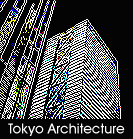
Perched above the Sumidagawa river, the building is a shiny black form with a giant gold flame rising up from its flat roof. The building itself is covered with highly polished black granite. Its windows are small portholes which are almost invisible from a distance. The walls of the building curve gently outward towards the top, creating in effect a giant pedestal for the gold flame on top. The flame itself, from which the beer hall and restaurant within take their names, rises several stories and looms over the Sumidagawa river as a gilded monument to Asahi beer. It is constructed of metal and weighs over 300 tons. The simulated gold leaf finish makes the flame gleam by day and by night, when it is illuminated. The shape of the flame is easily recognized as a trademark form of the designer. It appears in almost all of his interiors, either as a sconce or a door handle. This, however, is the first instance in which Starck has used the form on such a massive scale. Although it has been interpreted by the people at Asahi as being a symbol of the burning soul of the company, it is such a recognizable element in all of the architect's work that it is hard not to see it as either a designer label or the self-conscious imprint of an egotist. |
 The building is placed above a staircase made of glass blocks which is illuminated from behind at night. The staircase has all the shameless glamour of a set from a 1950's Hollywood musical. It is virtually impossible to walk by in the evening and not be tempted to walk up the illuminated stairs and enter the building.
The building is placed above a staircase made of glass blocks which is illuminated from behind at night. The staircase has all the shameless glamour of a set from a 1950's Hollywood musical. It is virtually impossible to walk by in the evening and not be tempted to walk up the illuminated stairs and enter the building.
The main entrance of the beer hall is marked by a curving gold panel which is the only punctuation mark along the otherwise uninterrupted surface of the shiny black facade. Passing behind the gold panel and through the doors one enters a fantasy space the likes of which could only have been created by Philippe Starck. The curving walls covered in gray velvet and inlaid with velvet rope, the twisting columns vaguely resembling human forms and the angular staircase all combine to create an otherworldly atmosphere. The designer's strikingly beautiful but uncomfortable metal-backed chairs are also part of the decor. In a striking example of what can go wrong after a project has been completed, plastic plaques with numbers have been glued to each custom-designed table in an apparent attempt to ease the jobs of the waiters. These plaques diminish greatly the otherwise surreal atmosphere of the space.
|
 The second floor has two dining rooms which can be reserved for private parties. Passing through velvet covered doors and pulled-back curtains one enters windowless banquet rooms furnished with velvet-covered chairs and the designer's trademark blue glass sconces. The overwhelming use of fabric creates an eerie silent atmosphere. The private dining rooms can be visited and should not be missed.
The second floor has two dining rooms which can be reserved for private parties. Passing through velvet covered doors and pulled-back curtains one enters windowless banquet rooms furnished with velvet-covered chairs and the designer's trademark blue glass sconces. The overwhelming use of fabric creates an eerie silent atmosphere. The private dining rooms can be visited and should not be missed.
This striking and unusual building is a must-see for anyone in the Asakusa area. Its flashy style is clearly in contrast with the anonymous gray buildings which are the norm in Tokyo, which only makes it more of a landmark. It is to the city's credit that such an unusual structure could have been built. The current management, however is already showing a certain amount of disregard for the unusual design of the building. Whether this structure can withstand the test of time and irresponsible management has yet to be seen.
Copyright (c) 1998, Max Bolstad
|
| NEXT | Setagaya Art Museum |
|
| |
|
|
Architecture table of contents |
|
| |
| bento.com main menu | |

 The fourth floor of the building is presently host to a discount clothing store which seems uncomfortably out of place amid the splendor of the rest of the building. Its presence is a reminder that the beer hall is in Tokyo's Shitamachi area which has seen better days.
The fourth floor of the building is presently host to a discount clothing store which seems uncomfortably out of place amid the splendor of the rest of the building. Its presence is a reminder that the beer hall is in Tokyo's Shitamachi area which has seen better days.